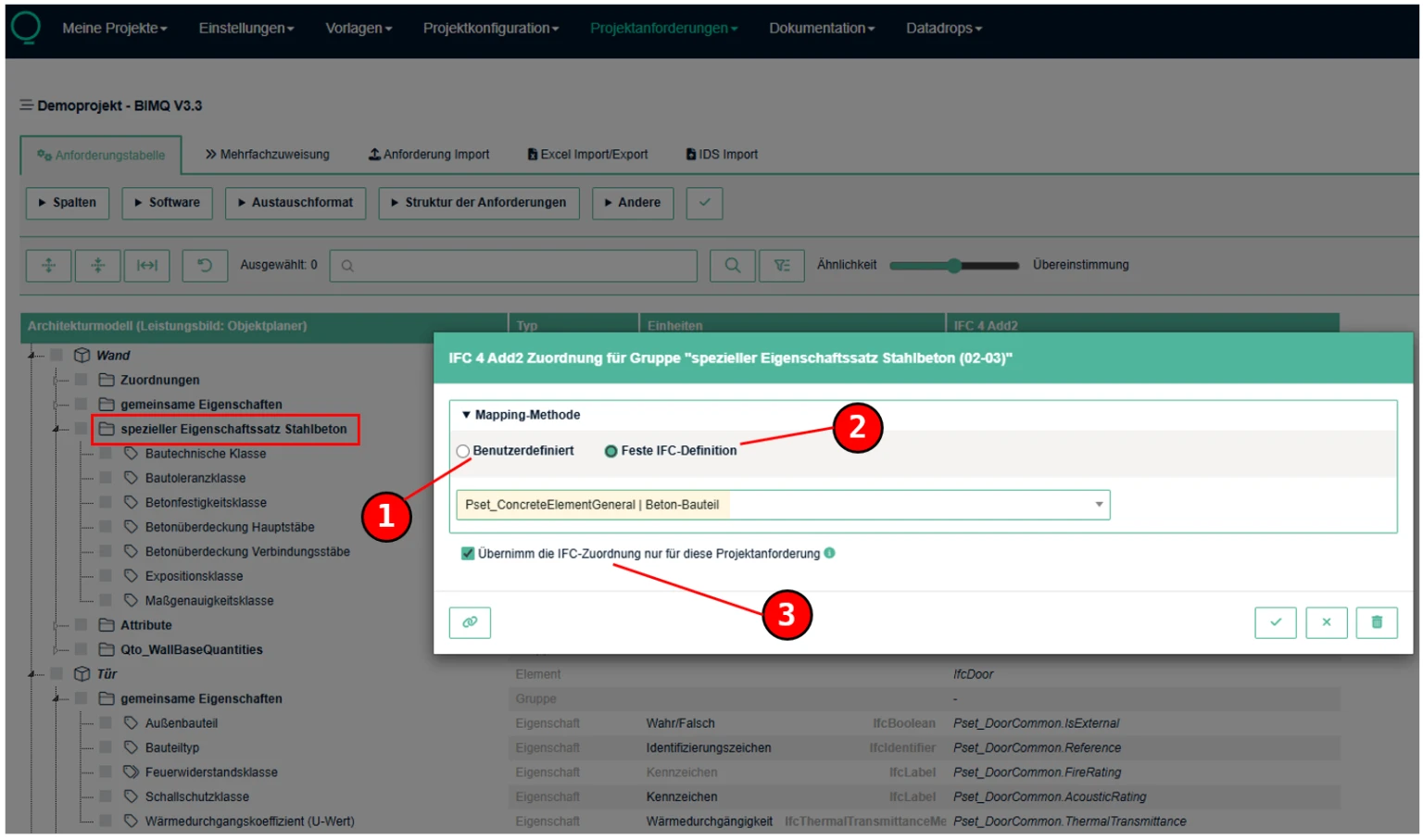IFC-Configuration
As part of the upgrade to BIMQ V3.3, the IFC configuration has been redesigned and expanded. This includes a restructuring of the IFC dialog and an expansion of the classes:
IfcMaterial
IfcClassification
The new dialog is currently available for group and property mapping and will be supplemented by element mapping in the upcoming update.
IFC-Group Mapping
In the dialog box for group mapping, you can choose between two mapping settings: User defined and Fixed IFC definition.
Figure: IFC mapping dialog for groups

In the example shown, the BIMQ group "spezieller Eigenschaftssatz Stahlbeton" is mapped to IFC4.
User definedWith this setting, you can configure completely customized group mapping. Definitions can be entered using the free input field. The entry stored here is used as a definition for the software templates and for checking.Fixed IFC definitionIf the option “Fixed IFC definition” is selected, all property sets available in the IFC schema used are available for selection. In the area “Project Requirements”, only those property sets are displayed that are also available for the selected IFC entity.Apply the IFC mapping only for this project requirementIf the checkbox is activated, the IFC mapping is only applied to this specific requirement. The definitions are not transferred to the component templates. Only when the checkbox is deactivated does synchronization with the component templates take place. This option is available for all IFC mapping dialogs. Further information can be found here.
IFC-Property Mapping
The IFC mapping dialog for properties is divided into 5 different mapping methods:
Property
Quantity
IFC Attribute
Material
Classification
Mapping to Properties
The mapping method for properties is divided into the options User defined, Dynamic IFC definition and Fixed IFC definition.
Figure: IFC mapping to properties

User definedOption for completely customized IFC mapping for the property group (optional) and the property. If no property group is defined, the # symbol is used by default (placeholder for the parent IFC group definition).Dynamic IFC definitionThis option includes all IFC common properties. IFC properties defined here always refer to the property set Pset_ElementCommon of the respective assigned IFC element. The addition [PsetCommon] visible in the BIMQ UI replaces the * symbol used previously.Fixed IFC definitionIf the option “Fixed IFC definition” is selected, all property sets and properties available in the IFC schema used are available for selection. In the area “Project Requirements”, only those property sets and properties that are also available for the selected IFC entity are displayed.
Mapping to Quantities
The mapping method for Quantities is divided into the options Dynamic IFC definition and Fixed IFC definition.
Figure: IFC mapping to quantities

Dynamic IFC definitionThis option includes all IFC base quantities that occur multiple times for different IFC entities. In the BIMQ UI, this is indicated by the suffix [QtoBase].Fixed IFC definitionIf the option “Fixed IFC definition” is selected, all base quantity sets and base quantities in the IFC schema used are available for selection. In the area “Project Requirements,” only the base quantity sets and base quantities that are also available for the selected IFC entity are displayed.
Mapping to IFC Attributes
IFC Attributes are fundamental properties that are directly linked to an IFC class. Attributes are part of the standard and cannot be extended freely. Unlike IFC Properties, IFC Attributes are never found in a specific Property Set (Psets).
Distinction: | |
Attribute | Fixed, predefined properties of an IFC entity |
Properties | Properties assigned via Psets, standardized or user-defined |
Figure: IFC mapping to attributes

The definition is made using the “IFC Attribute” mapping method. The five most important IFC attributes (Description, LongName, Name, Tag, ObjectType) can be selected. In the BIMQ UI, attributes are marked with the suffix [IFCAttribute].
Mapping to IfcMaterial
This mapping method checks for the existence of a material definition for the specified IFC class. The permissible name of the material can be defined by additional restrictions.
Figure: Definition of IfcMaterial

In the example, the Material property was mapped using the “Material” mapping method for the IFC4 ADD2 schema. The permissible value "Stahlbeton" was also specified for the Wall element. These settings can be defined via IFC Element Settings > Additional Classification by Property.
Note: The use of material/classification must currently be configured manually in the CAD software systems.
Mapping to IfcClassification
The mapping method “Classification” can be used to describe the mapping to any classification system. Here, IfcClassification defines the specific classification system, such as DIN 276, STLB-Bau, Uniclass (UK), OmniClass (USA), or eBKP-H (Switzerland).
Figure: Definition of IfcClassification

In the example, the Classification property was mapped using the “Classification” mapping method for the IFC4 ADD2 schema. DIN 276 was defined as the “Name of the classification system”. The elements in the IFC model should therefore reference the classification system: DIN 276.
The permissible value “331” was also specified for the wall element. In the DIN 276 classification system, this value corresponds to a “load-bearing exterior wall.” In the example shown, the check was defined specifically for all “IfcWall” elements that use the classification system “DIN 276” with the code “331”. These settings can be defined via the IFC Element Settings > Additional Classification by Property.
Note: The use of material/classification must currently be configured manually in the CAD software systems.

